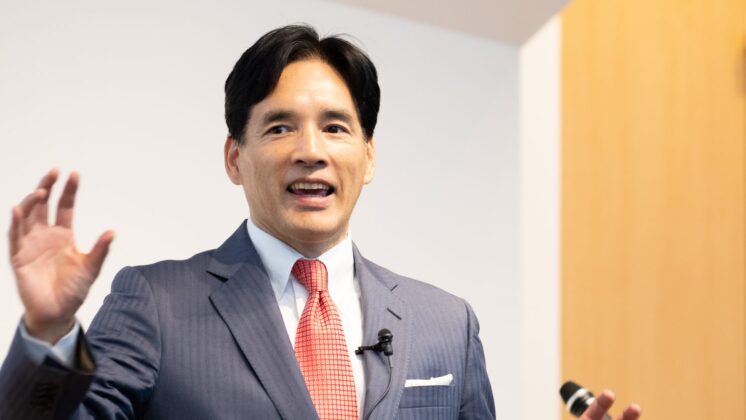Shaved snow produced a crunchy sound as my snowboard slid down the mountain. I gilded past fir trees right and left, shifting my weight on the board. With my eyes on silver snow dotted with black tree shades, I sledded downhill, with a sensation as if I were falling. Taking a rest midway down, I lay on the snow and looked up. The bright blue sky spread before me endlessly. I felt glad to be alive at that moment.
That’s right. I had decided to go snowboarding in Vail during my stay in Colorado. I arrived at Vail Airport by way of Denver a little past 9 p.m. A female cab driver met me at the airport and drove me to Vail. On the way, she helpfully provided me with information about Vail.
Vail Airport is located at an altitude of 1,990 meters. The town of Vail is about 2,400 meters above sea level, and is a 45-minute drive from the airport. Vail is a relatively new ski resort that opened for business in 1962. The U.S. Army had a training camp for its ski troops in a place nearby before and during World War II. Soldiers trained at this camp were sent to the fronts in Northern Italy. Many of these soldiers found jobs or recovered from their war injuries at other ski resorts following their return to the United States. Two such veterans had had their eyes on Vail, and began preparations to develop the town as a ski resort.
The two had no money, but the soldiers approached the federal government, which owned the local land, made an appeal for investment, and showed excellent entrepreneurial skills in getting their project off the ground. Initially, they asked investors to pay 10,000 dollars for shares with membership. The membership guaranteed free lifetime skiing at the resort being developed. At the time, though, the membership was practically worthless.
The two ex-soldiers managed to bring their plans to fruition in the winter of 1962. That winter, however, the early snowfall was minimal. Not knowing what to do, they asked local Native Americans to perform a traditional snow dance. The story has it that snow began falling suddenly after the prayer dance ended, and enabled the two entrepreneurs to open their ski resort for business. With this history, Vail has evolved over the years into the largest ski resort in the United States. The two founders have passed away, but they continue to command respect for what they achieved.
The ski resort of Vail has been operated by a private company. Some of the company’s investors resold their shareholdings following failures in other businesses. Later, the resort operator went public with the assistance of an investment bank. The company has grown into a major force, with six ski areas and as many hotels under its management. As a ski resort, Vail focuses on high-end customers. In the meantime, Beaver Creek, an affiliated resort that lies next to Vail, targets core skiers.
Listening to this story of the rise of Vail from the cab driver, I realized once again how healthy entrepreneurship and capital markets in the United States have been. I thought I could turn the story behind Vail into a Globis case study, because the project had a clear portfolio strategy. The history of Vail reminded me of a movie about the entrepreneur who built Las Vegas, which I had seen before. I found the movie quite moving. I would like more entrepreneurs to emerge from Japan. That’s why I set up Globis.
Vail is a compact town with a population of 2,000. Hotel rooms in Vail are absurdly expensive because this ski resort targets high-end customers. For that reason, I decided to share a hotel room with Mr. Hashimoto, a company president and my companion on this trip. My roommate in Vail seemed to have taken a shower and gotten into bed already. It was 30 minutes past midnight. I decided to take a shower and crawl into bed, too.
The next morning, I changed into a snowboarding gear complete with protectors and a helmet, rented a snowboard, and took a ski lift all the way up to the mountaintop. The sunlight was blinding. Sliding down from an altitude of 3,300 meters was a true blast. The snow was powdery and easy to slide on. But in the thin air I quickly ran out of breath. I made up my mind to enjoy my snowboarding at a leisurely pace.
After several downhill trips, I took a rest at an outdoor terrace near the summit. The snow-covered Rocky Mountains were beautiful. There was not a single cloud in the blue sky. I felt I must be close to heaven. I also felt thirsty because the air was so dry. Background music being played in the terrace was American rock from the 1980s. Before I knew it, I was humming a familiar tune. My body swayed naturally to the beat.
Saying to myself, “Let’s conquer the mountains,” I made the lift connections. There were four high mountains in Vail. They all stood 3,300 meters or higher above sea level. Two of them were connected, but the other two were not. I chose to climb the peak, slide 2,200 meters down to a nearby gorge, and go up again several times.
I took a break again, at a place 3,500 meters above sea level this time. I felt as if I was on a picnic, sitting on a bench surrounded with white snow and enjoying my drink and snacks. The peaks of the Rockies were the only thing I could see around me. It was a magnificent sight. The view comprised a range of white-tipped mountains with a blue sky in their background, and left me with a lasting impression.
This was high altitude, but it was surprisingly warm. I have found a face mask indispensable in Japan, but it was so warm up there that I didn’t feel the need to wear it. It felt like two or three degrees below zero. The difference between daytime and nighttime temperatures must be significant because the air was dry, I thought. The thin air was the most difficult part. I found myself quickly running out of breath. My bindings became loose and I slid down with my left foot knocking. I snowboarded carefully, cognizant of the dangers involved in this condition.
Chatting on lifts is a delight reserved for skiers and snowboarders. I met visitors from many countries on Vail’s lifts, including an elderly man from Australia who had been in town for two or three weeks, two young men from Chile, and a man in his 50s who came from Georgia. Many of them were senior skiers. Skiers surprised me in particular with their friendliness. Several of them called out to me when I opened my map.
When I lay down, they asked me if I was OK. They offered their pole to me, saying, “Here you are,” and they dragged me to a slope when my snowboard stopped on level snow. During our lift rides together, my friend and I wondered why they were so kind.
Finally, my knees were starting to knock. I reached my hotel, almost crawling, and worked off my physical fatigue in a Jacuzzi outside the hotel. After a nap, I went for a stroll through the streets of Vail. It was past 7 p.m. and the neat streets reminded me of Switzerland. I went into a steakhouse, telling myself I had travelled all the way to the United States. I ordered Caesar salad, French onion soup, and spareribs. I didn’t drink and went to bed early because I was starting to have a headache, a symptom peculiar to altitude sickness.
The weather changed from cloudy, to snow, to a blizzard, to occasionally clear on the following day. I didn’t know whether the reason was the time of day or the place, but the weather changed at a dizzying pace. In a snowstorm, I lost sight of my friend, who had belonged to a competitive ski team in his school days. Before I knew it, I had gone off course and entered a pine grove alone. I was worried about hitting trees or getting caught in the branches. With a slow slide, I managed to reach a point where I could see a lift.
I found my friend riding the lift by himself. He seemed to have run out of patience and chosen to climb the mountain again to search for me. I called out to him and asked him to wait at the foot of the mountain. The lift ride gave me precious time to recuperate from the fatigue that had continued from the previous day.
I took another ski lift up to the rest area located 3,500 meters above sea level, where I had taken a break the previous day. This time the area was in a blizzard. Everyone who had taken the lift took refuge in a rest house, which became packed. I had drunk cold Gatorade at the house the day before. This time I chose hot chocolate. I warmed myself with the hot drink, took a good rest, and started snowboarding again. All in all, I did the extra long course 10 times. I returned to my hotel exhausted, quickly changed clothes in my room, left the hotel for Vail Airport, and flew to Denver.
March 3, 2011
Yoshito Hori
Written on my flight back to Japan



